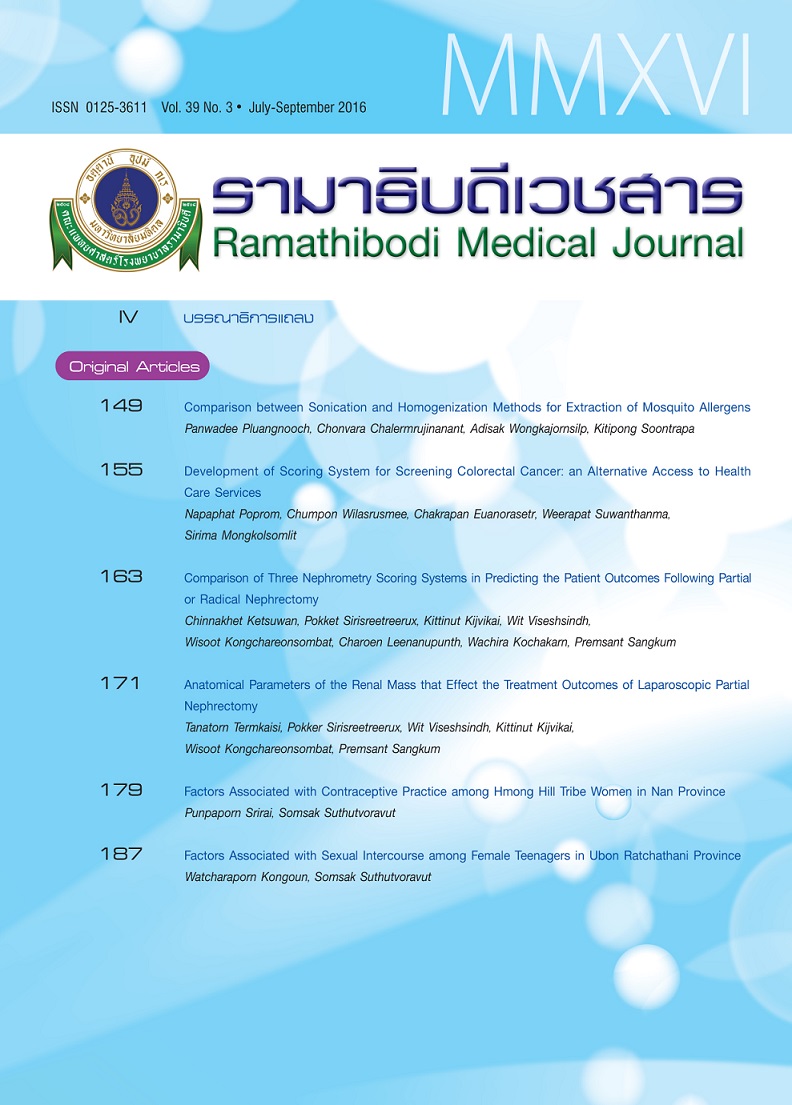A Comparison between Sonication and Homogenization Methods for Extraction of Mosquito Allergens
Keywords:
Allergen extract, sonication, homogenization, mosquitoAbstract
Objective: To compare sonication and homogenization methods for preparation of mosquito allergen extracts.
Materials and Methods: Mosquito allergens were extracted from Culex quinquefasciatus using two different methods, sonication and homogenization. Protein concentrations, protein profiles, and endotoxin levels in the extracts prepared by the two methods were determined.
Results: The protein concentrations measured by Bradford (results in mg/mL) and Kjeldahl (results in Protein Nitrogen Units, PNU) assays in the extracts prepared by the sonication method were 0.92 0.08 mg/mL and 74700
4934 PNU, respectively. These results were significantly higher than those in the extracts prepared by the homogenization method (0.64
0.01 mg/mL and 41330
8231 PNU). The protein fingerprint showed more protein in the extracts prepared by sonication than in those prepared by homogenization. The endotoxin levels in the extracts from both methods were clinically acceptable, and there was no bacterial contamination.
Conclusion: Sonication provides mosquito allergen extracts with higher quantities of proteins and better protein composition than homogenization.
References
Jarvis D, Burney P. ABC of allergies. The epidemiology of allergic disease. British Med J. 1998;316:607-10.
Barletta B, Pini C. Does occupational exposure to insects lead to species-specific sensitization? Allergy. 2003;58:868-70.
Fukutomi Y, Kawakami Y, Taniguchi M, Saito A, Fukuda A, Yasueda H, et al. Allergenicity and crossreactivity of booklice (Liposcelis bostrichophila): a common household insect pest in Japan. Int Arch Allergy Immunol. 2012;157:339-48.
Kulthanan K, Wongkamchai S, Triwongwaranat D. Mosquito allergy: clinical features and natural course. J Dermatol. 2010;37:1025-31.
Peng Z, Simons FE. A prospective study of naturally acquired sensitization and subsequent desensitization to mosquito bites and concurrent antibody responses. J Allergy Clin Immunol. 1998;101:284-6.
Peng Z, Simons FER. Mosquito allergy: immune mechanisms and recombinant salivary allergens. Int Arch Allergy Immunol. 2004;133:198-209.
Hach CC, Bowden BK, Kopelove AB, Brayton SV. More powerful peroxide Kjeldahl digestion method. J Assoc Off Anal Chem. 1987;70:783-7.
Hach CC, Brayton SV, Kopelove AB. A powerful Kjeldahl nitrogen method using peroxymonosulfuric acid. J Agric Food Chem. 1985;33:1117-23.
Grier TJ. Laboratory methods for allergen extract analysis and quality control. Clin Rev Allergy Immunol. 2001;21:111-40.
Kumar L, Sridhara S, Singh BP, Gangal SV. Characterization of cogon grass (Imperata cylindrica) pollen extract and preliminary analysis of grass group 1, 4 and 5 homologues using monoclonal antibodies to Phleum pratense. Int Arch Allergy Immunol. 1998;117:174-9.
Downloads
Published
How to Cite
Issue
Section
License
Copyright (c) 2016 By the authors. Licensee RMJ, Faculty of Medicine Ramathibodi Hospital, Mahidol University, Bangkok, Thailand

This work is licensed under a Creative Commons Attribution-NonCommercial-NoDerivatives 4.0 International License.













